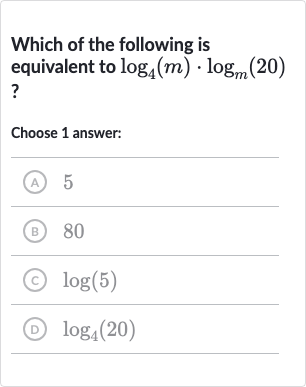Full solution
Q. Which of the following is equivalent to ?Choose answer:(A) (B) (C) (D)
- Use Change of Base Formula: We can use the change of base formula for logarithms, which states that . This is because is the exponent to which 'a' must be raised to get 'b', and is the exponent to which 'b' must be raised to get 'c'. When you multiply these, you get the exponent to which 'a' must be raised to get 'c'.
- Apply Change of Base Formula: Applying the change of base formula to , we get:
- Check Answer Choices: Now we need to check the answer choices to see which one matches our result. The correct answer should be .
- Identify Correct Answer: Looking at the answer choices, we see that (D) is the correct match for our result.
More problems from Product property of logarithms
QuestionGet tutor help
QuestionGet tutor help
QuestionGet tutor help
QuestionGet tutor help
QuestionGet tutor help



